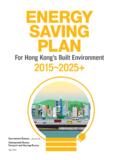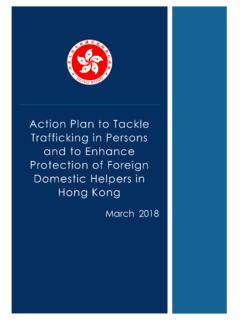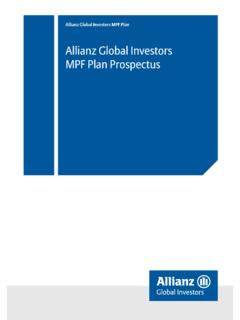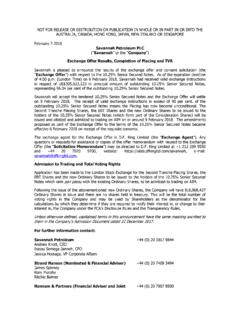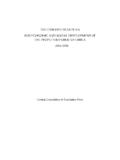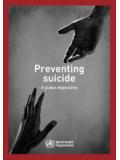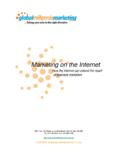Transcription of WHO/CDS/CSR/EDC/99.1 Influenza Pandemic Plan. …
1 WHO/CDS/CSR/ Pandemic plan . The Role of WHO and Guidelinesfor national and regional PlanningGeneva, SwitzerlandApril 1999 world health OrganizationDepartment of Communicable Disease Surveillance andResponseThis document has been downloaded from the WHO/CSR Web site. Theoriginal cover pages and lists of participants are not included. for more information. world health OrganizationThis document is not a formal publication of the world health organization (WHO), and all rights are reserved by the organization . The document may,however, be freely reviewed, abstracted, reproduced and translated, in part orin whole, but not for sale nor for use in conjunction with commercial views expressed in documents by named authors are solely theresponsibility of those authors. The mention of specific companies or specificmanufacturers' products does no imply that they are endorsed orrecommended by the world health organization in preference to others of asimilar nature that are not of Contents1 Executive Summary2 Introduction3 The role of the world health organization (WHO) Assessing the level of alert from novel Influenza viruses during inter- Pandemic periods3.
2 2 Phase 0: Inter- Pandemic Phase 0, Preparedness Level 1, new Influenza strain in a human Phase 0, Preparedness Level 2, human infection Phase 0, Preparedness Level 3, human transmission Phase 1: Confirmation of onset of Phase 2: regional and multi- regional Phase 3: End of the first Pandemic Phase 4: Second or later waves of the Phase 5: End of the Pandemic (back to Phase 0) WHO actions in the post- Pandemic phase4 The role of national health authorities and Pandemic planning Composition of the Establishing an effective management Deciding on vaccination Planning an overall control Strengthening surveillance Obtaining scientific and medical Ensuring pharmaceutical supplies and Legal - political - economic framework for Communications58869141515161617212122222 2232323242445 Issues on which national policy decisions will be Management Surveillance Scientific and medical Pharmaceutical supply and logistical Legal - political - economic Communications issues6 Conclusions7 Annex A: Influenza and its complications8 Annex B: Historical background9 Annex C: Origin of pandemics10 Annex D: Influenza vaccine11 Annex E: Anti-viral drugs12 Annex F: List of addresses.
3 WHO, WHO Collaborating Centres, national Influenza centres, Influenza vaccine manufacturers13 Annex G: national Pandemic plan3026262728283438434653556629265 This document has been prepared to assist medical and public health leaders tobetter respond to future threats of Pandemic Influenza . It outlines the separate butcomplementary roles and responsibilities for the world health organization ( WHO)and for national authorities when an Influenza Pandemic appears possible or actuallyoccurs. Specific descriptions are given of the actions to be taken by WHO as itassesses the risk posed by reported new sub-types of Influenza , in advance of anyepidemic spread. The responsibility for management of the risk from pandemicinfluenza, should it actually occur, rests primarily with national authorities. WHOstrongly recommends that all countries establish multidisciplinary NationalPandemic Planning Committees (NPPCs), responsible for developing strategiesappropriate for their countries in advance of the next recognition of the individuality of countries, as well as the unpredictability ofinfluenza, this document emphasizes the processes and issues appropriate for WHOand NPPCs, but does not provide a model plan .
4 Furthermore, it is anticipated thatNPPCs will confront new issues, which will call for additional international example, more consideration is needed about how scarce supplies of vaccinescan be shared, and what might be the benefit of cancelling public gatherings toslow the spread of a Pandemic virus among unvaccinated is impossible to anticipate when a Pandemic might occur. Should a true influenzapandemic virus again appear that behaved as in 1918, even taking into accountthe advances in medicine since then, unparalleled tolls of illness and death wouldbe expected. Air travel could hasten the spread of a new virus, and decrease thetime available for preparing interventions. health care systems could be rapidlyoverburdened, economies strained, and social order disrupted. Although it is notconsidered feasible to halt the spread of a Pandemic virus, it should be possible tominimize the consequences by having prepared for the challenge in in the absence of a Pandemic , as was seen in the US in 1976 and in HongKong SAR in late 1997, there can be rapid build up of public fear about even thepossibility of a Pandemic when a few cases of infection in humans with a new virussub-type occur.
5 Such fears about the existence of a dangerous new form of influenzavirus create major challenges for health authorities and national leaders, even whileepidemic spread of a new virus remains unconfirmed. To better cope with falsealarms resulting from intensive surveillance, a series of Preparedness Levels h a v ebeen defined that can be applied before the beginning of a Pandemic is should assist WHO to report on novel virus infections of humans and initiateprecautionary responses, without creating unnecessary panic. Such a need isparticularly important in an age when information is so rapidly shared by electronicmeans. Special efforts should continue to be made to expand the capabilities foruse of electronic communications by those conducting surveillance or assessingand managing the response to new Influenza viruses, and for the orderlydissemination of situation summary1 This document is available on the world health organization website,at inter- Pandemic periods, Influenza viruses circulate that are related to thosefrom the preceding epidemic.
6 The viruses are spreading among people with varyinglevels of immunity from infections earlier in life. Such circulation, over a period ofusually 2-3 years, promotes the selection of new strains which have changedenough to again cause an epidemic among the general population; this process istermed antigenic drift . Drift variants may have different impacts in differentcommunities, regions, countries or continents in any one year, although over severalyears their overall impact is often similar. Typical Influenza epidemics cause increasesin incidence of pneumonia and lower respiratory disease as witnessed by excessrates of hospitalization or mortality. The elderly or those with underlying chronicdiseases are most likely to experience such complications, but young infants alsomay suffer severe disease. The morbidity caused by Influenza viruses is described inAnnex unpredictable intervals, however, novel Influenza viruses emerge with a keysurface antigen (the haemagglutinin) of a totally different sub-type from strainscirculating the year before.
7 This phenomenon is called antigenic shift . If such viruseshave the potential to spread readily from person-to-person, then more widespreadand severe epidemics may occur, usually to a similar extent in every country withina few months to a year, resulting in a Pandemic . Annex B provides more informationon these issues, and Annex C discusses hypotheses about the origin of summary, each past Pandemic resulted from: the emergence of an Influenza A virus with a differenthaemagglutinin sub-type than strains circulating in humans for manypreceding years, and a high proportion of susceptible people in the community, , no orlow antibody titres to the haemagglutinin of the novel virus detectedin major segments of the population, and high person-to-person transmissibility of the new virus, withaccompanying human diseaseThe pandemics this century were in 1918, 1957, 1968 and to a lesser extent, in 1977( Table 3, Annex B). The Pandemic of 1918/19 was the most severe; an estimated 20million people died addition, there have been false alarms ( Table 3, Annex B).
8 For example, in the USin 1976 a localized outbreak, with a fatal index case, occurred among military death was due to an Influenza virus similar to that found in US swine. Suchviruses are related to those that caused the 1918 Pandemic . Response in the USincluded large-scale vaccine production under government contract, and a massvaccination campaign. However, the virus did not spread outside the training cases of swine Influenza virus infection in humans have been detected inthe US on several other occasions ( , in Wisconsin in 1988). Other examples7described in the lower part of Table 1 probably reflect the tip of the iceberg. Earlywarning of unusual or unexpected cases will rely upon a well-functioning veterinaryand human Influenza surveillance in 1997 there was concern about a potential Pandemic when human casesof an H5N1 virus sub-type were detected in Hong Kong SAR. The H5N1 virusesfound in humans related to viruses isolated from sick chickens in Hong Kong , intensive investigations failed to confirm efficient person-to-persontransmission of the virus, and the human infections stopped when public healthofficials and veterinarians organized mass destruction of chickens from marketsand their breeding of high growth reassortants for the production of an H5N1 vaccinestrain has been shown to be difficult and time consuming, due to technical problemsencountered during the selection processes ( , toxicity to the embryonated hen seggs).
9 More than 12 months elapsed after the occurrence of the index case in May1997 before such reagents were available for experimental vaccine production. Thisis to remind us that the rapid production of a suitable vaccine effective against apandemic Influenza strain might not be at hand and alternative control measureshave to be thought of in different histories show the need for flexible contingency plans capable ofresponding efficiently to a Pandemic threat. The purpose of this document is toprovide information and a framework to assist WHO and its Member States to beprepared to fulfil their roles and responsibilities in this addition to its role in collecting and analysing data on the occurrence of influenzaviruses around the world , WHO continuously provides information to healthauthorities, the media and the general public about current Influenza vaccinerecommendations, as well as of currently available anti-virals, through one of moreof the following methods.
10 Maintaining up-to-date summary reports on the WHOW orld Wide Web site (FluNet), reporting in the Weekly Epidemiological Record, informing national health authorities, national influenzacentres and other participants in the Influenza programabout the global Influenza situation, developing proposals to help guide national policymakers or those implementing national policies, and issuing press the level of alert from novel Influenza virusesduring inter- Pandemic periodsA new Pandemic virus may first be detected from significant and rapidly spreadingoutbreaks, as for example in 1957 and 1968. Nevertheless, it is important for effectiveplanning to have a process which defines responses to alternative possibilities, suchas the recognition of a new virus which does not spread and cause a Pandemic ,and the early detection of low-level spread of a true Pandemic definition of Preparedness Levels described here provides a basis for WHO todetermine its response to such situations as they are Levels 1, 2 and 3 correspond to events that would beoccurring in an inter- Pandemic period (which also may be stated tocorrespond to Pandemic Phase 0).










